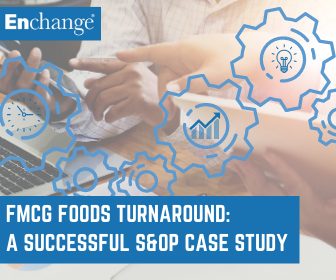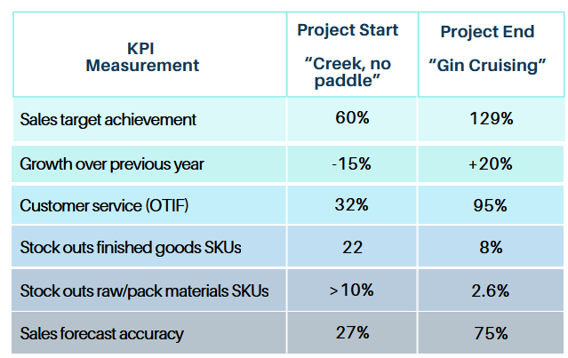 I know, I know. I know I am prone to rattle on about Sales & Operational Planning (S&OP) but seeing the benefits being delivered to previously struggling businesses is extremely motivating for a confirmed “techy” like myself. Not permitted professionally, but if only we could explicitly advertise such successes we would be able to interest and help other businesses in need of an S&OP boot camp, tender loving care or a completely new build.
I know, I know. I know I am prone to rattle on about Sales & Operational Planning (S&OP) but seeing the benefits being delivered to previously struggling businesses is extremely motivating for a confirmed “techy” like myself. Not permitted professionally, but if only we could explicitly advertise such successes we would be able to interest and help other businesses in need of an S&OP boot camp, tender loving care or a completely new build.
Here, I provide an outline case study of how one such business went from being a boat up a shark-infested creek without a paddle to sipping pink gins on a cruising, ocean going luxury liner.
The Challenge
This regional FMCG foods business did not have a formal planning process and so started from a lowly position on the Enchange Supply Chain maturity scale which allows benchmarking comparisons with unnamed peers in related sectors.
What was going on?
- Demand and supply planning forums existed but they were ad hoc, ill-disciplined and suffered from variable attendance. In addition, these meetings were not followed by a formal Finance Review nor any Pre-SOP and senior leadership S&OP meetings.
- The weekly demand planning meeting occasionally resembled an S&OP meeting. However, this was a “fire-fighting” opportunity to adjust the current month and even weekly, sales fluctuations.
- The forecast horizon was far too short particularly when considering significant peaks in the food industry, e.g. Ramadan, Christmas and Easter. At times, the demand horizon seemed to be 1 day firm and 4 days tentative!
- Departmental interaction consisted solely of unproductive blame-storming and silo behaviour with silo bombs being the weapon of choice.
- Supply and demand were clearly not balanced nor optimised within the business. Significant and repeated lost sales were experienced while inventory was managed on a reactive basis resulting in cyclic over and under-stocking. As a result, the business had failed to reach budgeted sales targets for a number of months and if nothing changed, this would inevitably continue.
The Approach
A 3 month project was designed with the business to implement S&OP. As the project progressed, the amount of external intervention and support gradually reduced allowing staff to take on their new responsibilities against a carefully managed schedule. This allowed the client team to slowly come to terms with S&OP, facilitate process integrity and establish leadership at the closure of the project.
All of the new processes and procedures were documented together with new organograms and job descriptions. A company-wide set of “recovery KPIs” was created and published in a dashboard format with clearly allocated roles and responsibilities for each. Post recovery the KPIs were gradually modified to reflect a business in far more control ad looking forwards instead of backwards.
The Result
The business was turned around as a direct result of this project. Budgeted monthly sales targets have been achieved or exceeded for 6 consecutive months. Amongst many other delivered enhancements, the following KPIs have been implemented and are measured monthly:

The Future
Clearly, this company is not yet the finished article but the improvements made in such a short time are staggering. As mentioned earlier, KPIs will require adjustment (as the company provides more and more fuel to the sales effort) to keep the performance bar rising and complacency avoided.
If you are reading this and the company described is not yours plus you operate in an FMCG market, one of your foods competitors just made a step change in market capabilities and performance! Be afraid, be very afraid.







